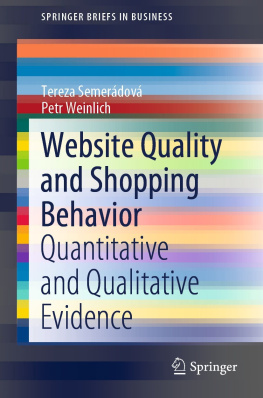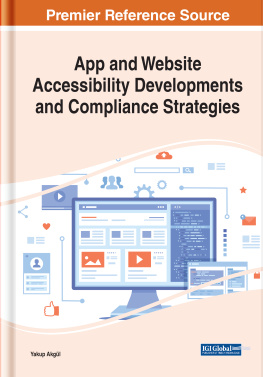Tereza Semerdov
Department of Informatics, Faculty of Economics, Technical University of Liberec, Liberec, Czech Republic
Petr Weinlich
Department of Informatics, Faculty of Economics, Technical University of Liberec, Liberec, Czech Republic
ISSN 2191-5482 e-ISSN 2191-5490
SpringerBriefs in Business
ISBN 978-3-030-44439-6 e-ISBN 978-3-030-44440-2
https://doi.org/10.1007/978-3-030-44440-2
The Author(s), under exclusive license to Springer Nature Switzerland AG 2020
This work is subject to copyright. All rights are solely and exclusively licensed by the Publisher, whether the whole or part of the material is concerned, specifically the rights of translation, reprinting, reuse of illustrations, recitation, broadcasting, reproduction on microfilms or in any other physical way, and transmission or information storage and retrieval, electronic adaptation, computer software, or by similar or dissimilar methodology now known or hereafter developed.
The use of general descriptive names, registered names, trademarks, service marks, etc. in this publication does not imply, even in the absence of a specific statement, that such names are exempt from the relevant protective laws and regulations and therefore free for general use.
The publisher, the authors and the editors are safe to assume that the advice and information in this book are believed to be true and accurate at the date of publication. Neither the publisher nor the authors or the editors give a warranty, expressed or implied, with respect to the material contained herein or for any errors or omissions that may have been made. The publisher remains neutral with regard to jurisdictional claims in published maps and institutional affiliations.
This Springer imprint is published by the registered company Springer Nature Switzerland AG
The registered company address is: Gewerbestrasse 11, 6330 Cham, Switzerland
Preface
Easier access to technology, the modernization of society, and the increased availability of smartphones now allow individuals to log on to the Internet more often, more quickly and with greater convenience. In April 2018, more than 4 billion people worldwide were actively using the Internet. The worlds largest statistical portal, Statista, states that Internet access is most often used to visit social networking sites and make online reservations and purchases. With the growing number of Internet users and the expanding e-business sector, the issue of identifying the ways in which consumers process digital information and the factors influencing customer browsing and purchasing behavior in the online environment are at the forefront of scientific investigation.
Website design is considered one of the key parameters of a companys Internet presentation, as it affects consumer attitudes and buying behavior. Therefore, online retailers try to find the elements and page layouts that will most attract users and contribute to extending the retailers web traffic. Understanding the cognitive processes triggered by web browsing and understanding the reasons for clicking is a starting point for user optimization and the personalization of digital objects, content, and page layouts. New technologies undoubtedly offer easier access to information in many ways. However, determining what information users need and how to provide it in an efficient and user-friendly way is often very problematic.
Web design has undergone many changes since the inception and expansion of the Internet, including the addition of graphics elements and page layouts, as well as the reformulation of a sites functional goals as a source of information. Web 1.0 was characterized by a degree of passivity on the part of the user, who only browsed the web content. A significant shift occurred with the transition to the second developmental decade of the Internet and the advent of Web 2.0 technologies in the form of social media and applications that allow users to generate Internet content while actively participating in a sites creation.
Although there is no clear definition of the third generation of the web, this generation is characterized by semanticism, artificial intelligence, 3D graphics, connectivity, and content accessibility at any time and from any device. Web 3.0 aims to simplify the search process for users. Information is no longer offered by search engines based solely on keywords but is filtered based on the keywords semantic meaning and context. The modern Internet user is no longer willing to search for required information but, on the contrary, expects information will be offered immediately without personal effort.
Research focusing on the complexity of website structures, the quality of the content presented, and the contents impact on the user experience is currently very extensive. However, the results and scientific conclusions in this area differ widely. Some scientists believe that simple websites are more efficient, while the results of other studies suggest that more complex websites, due to the greater richness of information, positively influence the users relationship with the site and provide greater added value.
Although previous research consistently confirms the existence of a link between the complexity of a website, cognitive load, and the ability of the user to process the presented information, these results cannot be objectified. Many factors affect the web browsing experience, including the type and information intensity of a user search session. The complexity of a task can be defined as the amount of information related to a task that an individual has to process in order to finish it. Complex tasks, therefore, require more cognitive work and more available information. This suggests that different site structures will be appropriate for different types of tasks. Other factors that also need to be included in the analysis are the personality characteristics of the consumer and the external incentives affecting his initial motivation and subsequent processing of information. Consumers tend to analyze more deeply and with greater awareness the information that is the most relevant to the area of their interest in the moment.
In the context of Web 3.0 technologies, web design must face new challenges in the form of personalized content. The online consumer community is a highly heterogeneous complex. The main goal of personalization is to satisfy the needs of all individuals from this whole through tailored content based on each individuals requirements, interactions, and perceptions.
Web design consists of creating an appropriate structure for both multimedia and text content in order to maximize the desired business goals and conversion actions. Hence, finding a suitable combination of design parameters is a key prerequisite for the commercial effectiveness of a website. Currently, when automated web personalization for subgroups of web users emerges, creating a conceptual model of user preferences based on web design factors represents an essential building block. Usability research, user experience, and the latest version of the ISO 9241 quality standards for information system development have not yet given a precise definition of quality in relation to websites and online applications. Usability, flexibility, security, efficiency, performance, satisfaction, quality of information, and clarity are the most frequently mentioned factors in relation to the quality of web applications. However, none of the worlds standards provides specific procedures and metrics that would allow us to measure the quality of web applications.












